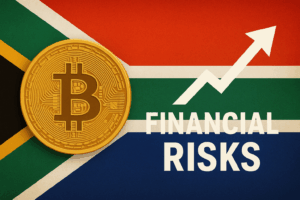Summary:
The South African Reserve Bank (SARB) has identified cryptocurrencies and stablecoins as new financial-stability risks in its latest assessments, citing rapid user growth, rising trading volumes and the limited regulatory coverage of these instruments. The central bank urged closer supervision and highlighted potential spillovers to the banking system and capital-flow management.
Key takeaways
- SARB’s 2025 Financial Stability Review names crypto assets and stablecoins as an emerging risk given their fast growth and limited oversight.
- The report warns that stablecoins now account for a large share of crypto trading activity, raising run-risk and market-stress concerns similar to those flagged by global authorities.
- The central bank underscored that digital-asset flows can complicate foreign-exchange controls and that regulatory gaps could allow risks to build up unnoticed.
What SARB said (and why it matters)
In its semi-annual Financial Stability Review and related commentary, SARB said that the rapid, lightly regulated expansion of crypto-asset use—particularly stablecoins—poses material risks to the country’s financial stability. The bank highlighted three channels of concern:
- Payment and liquidity risks: Stablecoins are increasingly used as a settlement medium and account for a growing share of crypto trading volumes, which could create redemption or “run” dynamics in stressed conditions.
- Cross-border and FX pressure: Because stablecoins are inherently cross-border, rising use could weaken the effectiveness of capital-flow and foreign-exchange management tools in emerging markets. SARB warned this could be particularly acute where stablecoins effectively “dollarize” local activity.
- Indirect bank exposures: Banks and non-bank financial firms get connected to crypto through custody, client deposits, and other services — concentrating risk in specialist institutions or lines of business and potentially transmitting stress into the broader financial system.
SARB’s treatment of crypto as a rising risk does not amount to an immediate ban, but it signals intent to tighten oversight and coordinate with other regulators to reduce blind spots in supervision.
Regional and global context
SARB’s stance echoes concerns voiced by other major regulators and international bodies this year:
- The Financial Stability Board (FSB) and the Bank for International Settlements (BIS) have warned about the systemic implications of unregulated stablecoins and the need for international standards.
- The European Central Bank recently cautioned that large stablecoins could siphon deposits from banks and create vulnerabilities in money-market structures.
For African markets in particular, analysts note that stablecoins already account for a large share of crypto volumes in some countries and are being used for payments, remittances and trading — intensifying the need for tailored, proportionate oversight.
What regulators and market participants may do next
- Stronger regulation and licensing: SARB is likely to press for clearer rules on issuers, custodians and intermediaries — including reserve-asset requirements and AML/KYC obligations.
- Enhanced monitoring: Expect expanded data collection on stablecoin flows, exchange activity and custody arrangements to detect buildups of systemic risk early.
- Cross-border coordination: Given the inherently global nature of stablecoins, SARB will probably coordinate with international peers to ensure standards for issuers and redemption mechanisms are enforceable.
- Industry response: Crypto firms and exchanges operating in South Africa may face higher compliance costs and new licensing hurdles; some products or intermediaries could be adjusted to be more transparent or onshore.
Bottom line
The South African Reserve Bank’s warning elevates the status of crypto and stablecoins from niche market developments to macro-prudential concerns. While the move does not ban crypto activity outright, it marks the start of a likely period of tighter supervision and deeper regulatory engagement — both domestically and with international standard-setters — aimed at preventing small pockets of crypto-related activity from becoming a source of broader financial stress.
Also Check: NYSE Arca Certifies Listing for Franklin Templeton Investments’s Spot XRP ETF (Ticker XRPZ)
